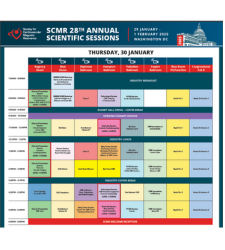Quick Fire Cases
Everything, Everywhere, All at Once: Can neonatal heterotaxy be comprehensively evaluated with a single 4D flow sequence? (QF_TH_027)
- AP
Abinash Pandey, MD
Pediatric Cardiology Fellow, PGY5
SSM Health Cardinal Glennon Children's Hospital - AP
Abinash Pandey, MD
Pediatric Cardiology Fellow, PGY5
SSM Health Cardinal Glennon Children's Hospital - WK
Wilson King, MD
Assistant Professor of Pediatric Cardiology
Saint Louis University - DM
Dipika Menon, MD
Assistant Professor
SSM Health Cardinal Glennon Children's Hospital - AA
Attila Ahmad, MD
Assistant Professor
SSM Health Cardinal Glennon Children's Hospital
Presenting Author(s)
Primary Author(s)
Co-Author(s)
A one day old 3.3 kg infant was prenatally diagnosed with complex congenital heart disease and transferred to our institution intubated and mechanically ventilated on a prostaglandin infusion with oxygen saturations in the 80s. Postnatal echocardiogram showed infradiaphragmatic total anomalous pulmonary venous return (TAPVR) with a vertical vein draining into the hepatic veins, complete atrioventricular canal with balanced ventricles, a common atrium, pulmonary atresia, and a large tortuous ductus arteriosus. Due to the complexity of malformations, cardiac MRI was performed on DOL 2, the morning of the scheduled operation.
Diagnostic Techniques and Their Most Important Findings: MRI:
Technique:
The patient underwent CMR using a 3T GE 750W Discovery scanner with a 16-channel large flex coil after administration of ferumoxytol 11 mg (3.2 mg/kg) given over 15 minutes while intubated and sedated. After localizers were obtained, a single 4D flow pulse sequence was performed with an acquired spatial resolution of 1.0 x 1.0 x 1.2 mm resolution, a temporal resolution of 21 ms, 5 signal averages, HyperKat acceleration factor of 5, respiratory compensation factor of 10% and a total scan time of 23 minutes.
Most important findings:
- Heterotaxy (A,L,D), right atrial isomerism, dextrocardia, infradiaphragmatic TAPVR, unbalanced left dominant AV canal, D-TGA with right ventricle giving rise to the aorta, pulmonary atresia, PDA with angled left pulmonary artery.
- A narrow vertical vein ran between bilateral upper and lower pulmonary veins, straddling the interatrial septum.
- Blood flow across the liver with infradiaphragmatic TAPVR is clearly demonstrated, with flow into vertical vein entering the portal system, and flow subsequently appearing across all hepatic veins presumably through hepatic sinusoids with a closed ductus venosus.
- Left pulmonary artery was acutely angled at the insertion site of the PDA, raising concern for possible left pulmonary artery stenosis.
- Right atrial isomerism with associated twin AV nodes explained the patient’s variable QRS morphology during sinus rhythm and preoperative supraventricular tachycardia.
- Qp:Qs was 0.8:1 by both branch PA/Aortic-PDA comparison and Pulmonary vein/ caval flow comparison.
<
Learning Points from this Case: 1. Neonates with heterotaxy can be evaluated with a single 4D flow sequence to understand cardiac anatomy, vascular anatomy, function, and flow.
2. Abnormal pulmonary venous anatomy can be resolved in high spatial resolution with 4D flow, a critical detail for planning the patient’s complex operation.
3. Abnormal blood flow across the liver in the setting of infradiaphragmatic TAPVR is clearly illustrated with 4D flow across the vertical vein, portal system, sinusoids, and hepatic veins.

